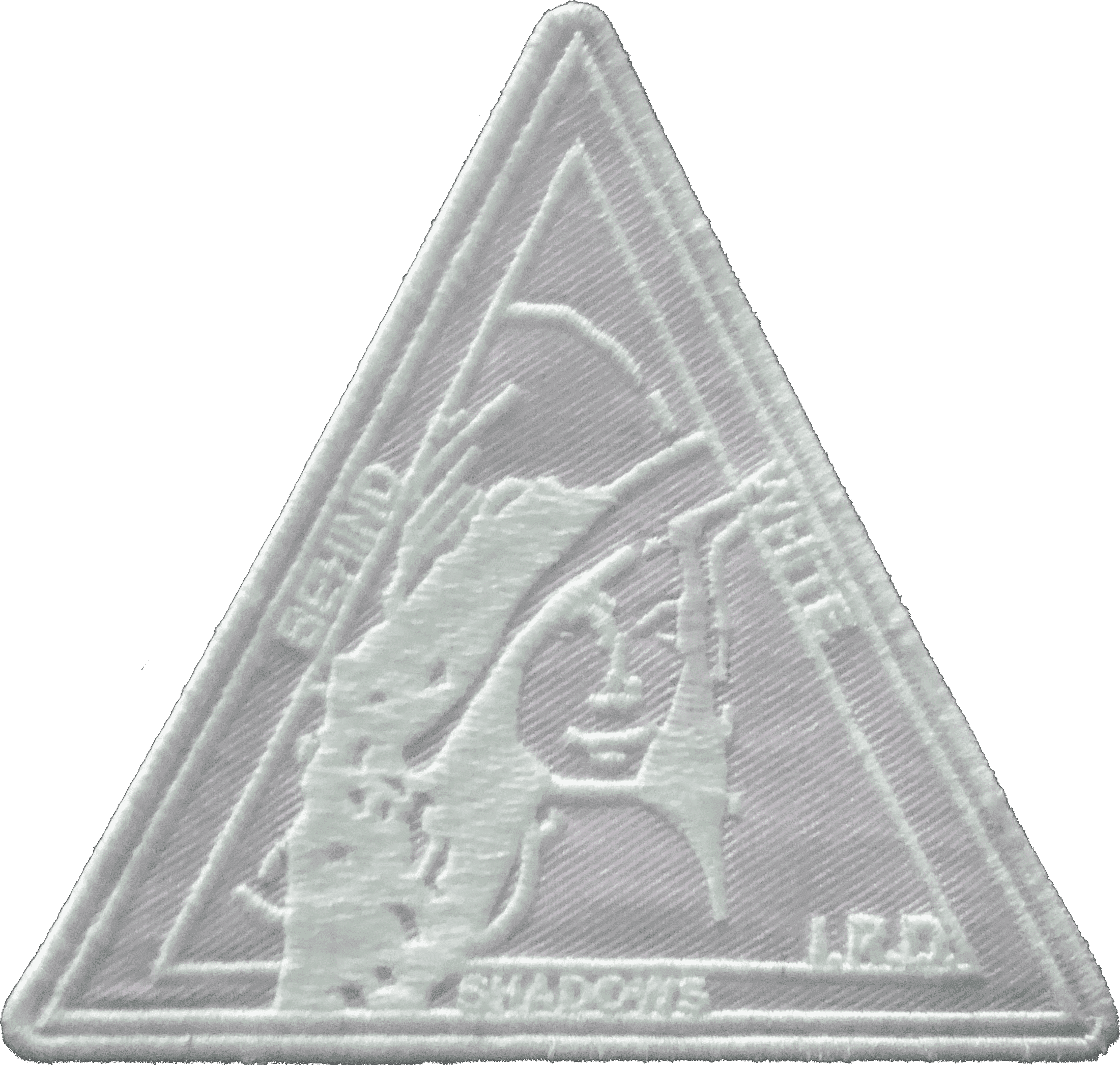Behind White Shadows: Glow in the Dark Patch

Addendum: Specters controlling our imaging technologies
In a culture that is dominated by images, we need to realize that (new) digital image processing technologies - whether based in classic image compression, biometrics or the newest machine learning algorithms, consist of some of the most influential, political but also biased and inherently flawed protocols, test and reference sets.
We should be more conscious of the war that is unfolding in the realms of image processing technologies. A war that takes place on many levels; on the plane where images are produced and the biased ideologies these images internalize and that often function at the expense of the marginalised. Besides, we should not only be conscious of the constructed realities these images offer, but also of the parts of reality they do not capture and as a result, of the economies these images sustain.
As adversaries in a war, we need to pronounce ‘colour’, or the side we are on. Our side is in need of a patch. A patch that signifies the issues wefight for.
This is why I created the white on white (glow in the dark) ‘the Lena’ patch.
While taking an image of the face and saving it to memory seems like a simple, straightforward act, in reality a large set of protocols intervene in the processes of saving the face to memory, including, but not limited to scaling, reordering, decomposing, and reconstituting image data, in favour of certain affordances, which cater to techno-conventional, political, and historically biased settings. Some of these biases can be traced back to the history of the color test card; a history which can offer an insightful perspective on how image compression standards have come to exist.
The first color test cards were developed almost a century ago. They would feature a ‘normal’ Caucasian, anonymous, brightly dressed girl, smiling friendly at the camera. Throughout the many legacy histories of image processing—including, but not limited to analogue photography, film, television, the JPEG algorithm and even Photoshop effects—this trope grew into a habitual, racial bias, violently lodged under the fold of image processing. The habitual use of Caucasian test cards such as the Lena photo, led to the development of certain affordances in the compression algorithm, scaling or sometimes even cutting away certain image data. It is important to be aware that a bias does not just influence the final rendering of the image; the bias also exists in what a technology does not show; what it obscures or obfuscates and what image data simply deletes. The Shirleys but, more importantly, the technicians that implemented the use of these Shirleys or color reference cards cast white shadows; patches of unregistered information during image processing. And while artists such as Hito Steyerl or Constant Dullaart make an effort to spread awareness around the biases and habits that are embedded in the histories of resolution setting, even today, the stories of these specters influencing our images - albeit invisible to the unaware observer - are often missing.
Six years after releasing A Vernacular of File Formats, and after close study of some of the histories of standardization and resolution setting, I realise that by using my own face as a Shirley card for de-calibration, I unintentionally aligned myself with the historical trope of the Caucasian test card. Just as Jeff Seidemann once said about Lena: “when you use a picture often, it becomes just pixels”– my face had become just pixels, or even, I had simply lost my face: it no longer belonged to me, but had become an anonymous image, ready for co-optation.
One way to make the habitual whiteness of color test cards more apparent, is indeed by insisting that these standard images, that often are trapped in the histories of our technologies, become part of the public domain. These images need to lose their elusive power. The stories of standardization belong to highschool text books, and the possible violence of standardization should be studied in any curriculum. By illuminating the histories of standardization, we will also see its white shadows.
Behind White Shadows
The JPEG image compression technology is one of the most archaic, but at the same time most contemporary artifacts from the realm of image processing. The algorithm still absolutely dominates the field of image compression, while its basis - the DCT algorithm - is also used in other compression technologies. DCT and JPEG in general have been a rich source of inspiration to me, inspiring me to create multiple works, such as DCT and DCT:SYPHONING.
I came across the story of Lena when I was invited to tell my own story of losing my face to the internet during the conference of Elevate festival in 2016. The image, produced in 2010, has seen many copies and appropriations and somehow I have lost authorship over it - it no longer seems to belong to me. In this way I experienced how strange it can be when your face becomes “just pixels”.
Last May I was asked to lend the image to Vogue (the US fashion magazine). I took this as an opportunity to reclaim the image in the only way I could imagine possible - by renaming the portrait formally known as “Blinx (from a Vernacular or File Formats)” to “A Ghost for De-calibration”. With this small, probably to most invisible action, I wish to take a stand against the discourse of color test cards and promote the consideration and creation of alternative cards and resolutions.
A great deal of inspiration for this text came from the amazing research undertaken by Lorna Roth, Researcher at Concordia University: Looking at Shirley, Colour balance project, video: color film was build for white people. Here's what it did to dark skin.
I would also like to reference James Bridles Render Ghost research “The Render Ghosts” (2013) in which he first connected the stories of Lena and Jennifer Knoll.
In a culture that is dominated by images, we need to realize that (new) digital image processing technologies - whether based in classic image compression, biometrics or the newest machine learning algorithms, consist of some of the most influential, political but also biased and inherently flawed protocols, test and reference sets.
We should be more conscious of the war that is unfolding in the realms of image processing technologies. A war that takes place on many levels; on the plane where images are produced and the biased ideologies these images internalize and that often function at the expense of the marginalised. Besides, we should not only be conscious of the constructed realities these images offer, but also of the parts of reality they do not capture and as a result, of the economies these images sustain.
As adversaries in a war, we need to pronounce ‘colour’, or the side we are on. Our side is in need of a patch. A patch that signifies the issues wefight for.
This is why I created the white on white (glow in the dark) ‘the Lena’ patch.
While taking an image of the face and saving it to memory seems like a simple, straightforward act, in reality a large set of protocols intervene in the processes of saving the face to memory, including, but not limited to scaling, reordering, decomposing, and reconstituting image data, in favour of certain affordances, which cater to techno-conventional, political, and historically biased settings. Some of these biases can be traced back to the history of the color test card; a history which can offer an insightful perspective on how image compression standards have come to exist.
The first color test cards were developed almost a century ago. They would feature a ‘normal’ Caucasian, anonymous, brightly dressed girl, smiling friendly at the camera. Throughout the many legacy histories of image processing—including, but not limited to analogue photography, film, television, the JPEG algorithm and even Photoshop effects—this trope grew into a habitual, racial bias, violently lodged under the fold of image processing. The habitual use of Caucasian test cards such as the Lena photo, led to the development of certain affordances in the compression algorithm, scaling or sometimes even cutting away certain image data. It is important to be aware that a bias does not just influence the final rendering of the image; the bias also exists in what a technology does not show; what it obscures or obfuscates and what image data simply deletes. The Shirleys but, more importantly, the technicians that implemented the use of these Shirleys or color reference cards cast white shadows; patches of unregistered information during image processing. And while artists such as Hito Steyerl or Constant Dullaart make an effort to spread awareness around the biases and habits that are embedded in the histories of resolution setting, even today, the stories of these specters influencing our images - albeit invisible to the unaware observer - are often missing.
Six years after releasing A Vernacular of File Formats, and after close study of some of the histories of standardization and resolution setting, I realise that by using my own face as a Shirley card for de-calibration, I unintentionally aligned myself with the historical trope of the Caucasian test card. Just as Jeff Seidemann once said about Lena: “when you use a picture often, it becomes just pixels”– my face had become just pixels, or even, I had simply lost my face: it no longer belonged to me, but had become an anonymous image, ready for co-optation.
One way to make the habitual whiteness of color test cards more apparent, is indeed by insisting that these standard images, that often are trapped in the histories of our technologies, become part of the public domain. These images need to lose their elusive power. The stories of standardization belong to highschool text books, and the possible violence of standardization should be studied in any curriculum. By illuminating the histories of standardization, we will also see its white shadows.
Behind White Shadows
The JPEG image compression technology is one of the most archaic, but at the same time most contemporary artifacts from the realm of image processing. The algorithm still absolutely dominates the field of image compression, while its basis - the DCT algorithm - is also used in other compression technologies. DCT and JPEG in general have been a rich source of inspiration to me, inspiring me to create multiple works, such as DCT and DCT:SYPHONING.
I came across the story of Lena when I was invited to tell my own story of losing my face to the internet during the conference of Elevate festival in 2016. The image, produced in 2010, has seen many copies and appropriations and somehow I have lost authorship over it - it no longer seems to belong to me. In this way I experienced how strange it can be when your face becomes “just pixels”.
Last May I was asked to lend the image to Vogue (the US fashion magazine). I took this as an opportunity to reclaim the image in the only way I could imagine possible - by renaming the portrait formally known as “Blinx (from a Vernacular or File Formats)” to “A Ghost for De-calibration”. With this small, probably to most invisible action, I wish to take a stand against the discourse of color test cards and promote the consideration and creation of alternative cards and resolutions.
A great deal of inspiration for this text came from the amazing research undertaken by Lorna Roth, Researcher at Concordia University: Looking at Shirley, Colour balance project, video: color film was build for white people. Here's what it did to dark skin.
I would also like to reference James Bridles Render Ghost research “The Render Ghosts” (2013) in which he first connected the stories of Lena and Jennifer Knoll.



